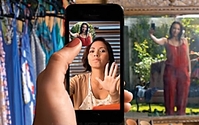Snapchat Launches 'Our Story,' Builds Community Perspective
- by Gavin O'Malley @mp_gavin, June 18, 2014
 As part of
a broader shift away from ephemeral exchanges, Snapchat debuted “Stories” late last year -- a feature that lets users save and share photos for up to 24 hours.
As part of
a broader shift away from ephemeral exchanges, Snapchat debuted “Stories” late last year -- a feature that lets users save and share photos for up to 24 hours.
Adding a collaborative component to the service, the start-up just unveiled “Our Story” so people at the same events can combine their own “snaps” into a single “story.”
“We wanted to build something that offered a community perspective,” the company explains in a blog post. “If you can’t make it to an event, watching Our Story makes you feel like you’re right there.”
Until recently, vanishing pictures have helped Snapchat stand out in a market dominated by giants like Facebook and Apple. This week, however, Facebook debuted Slingshot -- a standalone app for sharing photos and brief videos with friends.
Likely anticipated direct competition from Facebook, Snapchat has been pushing into more mainstream mobile messaging services. It recently rolled out a text- and video-messaging feature named Chat, while making it easier for users to save their exchanges with friends.
As Facebook’s $19 billion WhatsApp deal made outrageously clear, mobile messaging is big business -- and increasingly key to reaching consumers.
Yet as a recent white paper from IPG Media Lab showed, the messaging space is beyond cramped. Along with Facebook Messenger -- in which the social giant continues to invest -- services Kik Messenger, WeChat, Line and Tango are all competing for user affections.
As various surveys suggest, the pool of potential users continues to grow -- and especially among young users who are spending more of their time on social apps like Instagram, Snapchat, and Vine.
Never far behind young consumers, brands have been happy to experiment with Snapchat. Following Taco Bell’s lead, McDonald's joined the service earlier this year, while Heineken recently relied on Snapchat to connect with festival goers at Coachella.
Among brands, other early adopters include Juicy Couture, Seventeen magazine, NPR and HBO's "Girls."


